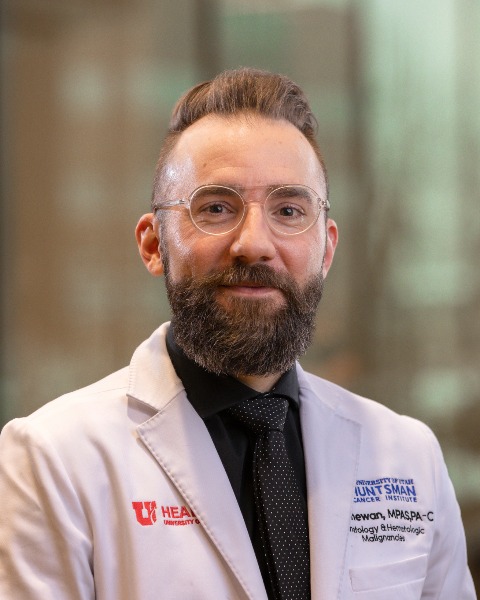Nursing Symposium
Poster Session 1
NSP-14: Project to Improve Volume of Treatment and Satisfaction (PIVOTS): Optimizing Physician and Advanced Practice Provider Workflow
Wednesday, September 27, 2023
1:30 PM - 2:30 PM EEST


Samuel Shewan, PA-C (he/him/his)
Advance Practice Provider
Huntsman Cancer Institute
Murray, Utah, United States
Introduction: Huntsman Cancer Institute Plasma Cell Dyscrasia (PCD) Program is the primary referral center in the Mountain West. In 2021, we reported on a project to improve our care model to optimize clinical efficiency. Here we provide an update on this quality improvement project. We hypothesized that utilizing a contemporary clinical model would improve efficiency and Relative Value Unit (RVU) generation, enhance job satisfaction for all clinical team members while maintaining high patient satisfaction scores. This model, called Project to Improve Volume of Treatment and Satisfaction (PIVOTS) is focused on 4 fundamental pillars: 1) Modifying physician and APP clinic templates to optimize daily clinic volumes; 2) Establishing specific “divisions of labor” for patient follow-up; 3) Standardization of post-autologous transplant follow-up; and 4) Standardization of documentation practices via standardized note templates and intelligent text. The goal of this project was to improve our practice model to optimize patient care, productivity and team morale.
Methods: Clinic template adjustments: Physician schedule templates included all New Patient Visits (NPV), follow-up visits with disease reassessment or treatment change, and visits per patient request. We eliminated the ability to double book on the MD schedule. There were defined instances for shared MD/APC visits: NPV with active MM, transplant consent, and treatment change or progression. Independent APP schedule templates included surveillance visits, clinical trial visits, and post-ASCT. The general approach is that patients with well controlled myeloma alternate between the MD and APP schedule on a 2 and 4-month or 3 and 6-month basis. To maximize efficiency, note templates and intelligent text were standardized for all physicians and APPs in the 6 months prior to starting PIVOTS.
Results: Three outcome measures were defined before the start of the project based on our hypothesis: 1) Employee Satisfaction Rating; 2) APP wRVUs; and 3) Patient Satisfaction. Each outcome was assessed quarterly between May 2021 and May 2022. As measured from a survey, employee satisfaction improved from 50% to 71%. APP wRVUs increased from 1427 to 2397 per APC. Patient satisfaction scores based on the likelihood to recommend practice from the Press Ganey survey improved from 93% to 98%.
Conclusions: Implementing PIVOTS has increased clinical efficiency, improved workforce satisfaction, and improved patient satisfaction scores. Importantly, these successes occurred during the COVID pandemic and during a period of growth in which clinic volumes increased > 100% between 2019 and 2022. While PIVOTS was piloted for a single physician schedule template, we now use this model for all clinical faculty in the PCD Program. Our outcomes justify the ongoing application of PIVOTS and we believe that “pivoting” patients between independent physician and APP schedules allows for significant workflow flexibility and allows our APPs to function at the top of their licensure.
Methods: Clinic template adjustments: Physician schedule templates included all New Patient Visits (NPV), follow-up visits with disease reassessment or treatment change, and visits per patient request. We eliminated the ability to double book on the MD schedule. There were defined instances for shared MD/APC visits: NPV with active MM, transplant consent, and treatment change or progression. Independent APP schedule templates included surveillance visits, clinical trial visits, and post-ASCT. The general approach is that patients with well controlled myeloma alternate between the MD and APP schedule on a 2 and 4-month or 3 and 6-month basis. To maximize efficiency, note templates and intelligent text were standardized for all physicians and APPs in the 6 months prior to starting PIVOTS.
Results: Three outcome measures were defined before the start of the project based on our hypothesis: 1) Employee Satisfaction Rating; 2) APP wRVUs; and 3) Patient Satisfaction. Each outcome was assessed quarterly between May 2021 and May 2022. As measured from a survey, employee satisfaction improved from 50% to 71%. APP wRVUs increased from 1427 to 2397 per APC. Patient satisfaction scores based on the likelihood to recommend practice from the Press Ganey survey improved from 93% to 98%.
Conclusions: Implementing PIVOTS has increased clinical efficiency, improved workforce satisfaction, and improved patient satisfaction scores. Importantly, these successes occurred during the COVID pandemic and during a period of growth in which clinic volumes increased > 100% between 2019 and 2022. While PIVOTS was piloted for a single physician schedule template, we now use this model for all clinical faculty in the PCD Program. Our outcomes justify the ongoing application of PIVOTS and we believe that “pivoting” patients between independent physician and APP schedules allows for significant workflow flexibility and allows our APPs to function at the top of their licensure.
